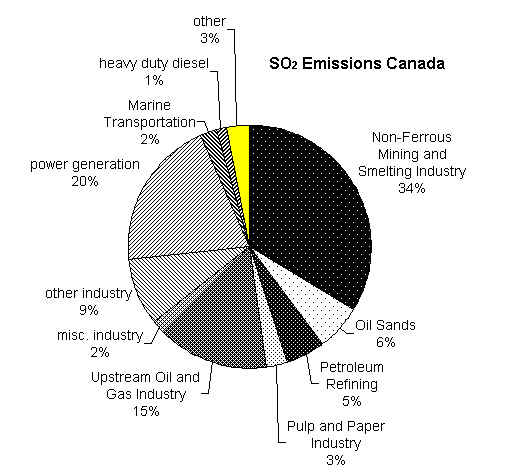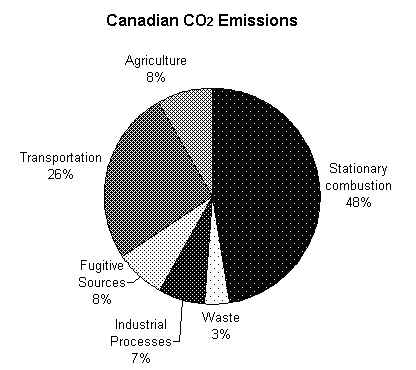Sources of NOx,
SO2 and CO2 in Canada (1995 data:
see
Environment Canada)
Nitrogen
monoxide, NO, and nitrogen dioxide, NO2, lumped together as NOX
contribute to both and acidic precipitation and photochemical smog. Sulfur
dioxide, SO2 leads to sulphate pollution and also to acidic
precipitation. CO2 contributes to global warming. In most literature, industrial emissions are reported to be the
main sources of SO2, while the transportation sector is held
responsible for most emissions of NOX. Environment Canada’s web page
offers a very detailed view of how various human activities contribute to these
forms of pollution, but I focused on the main culprits and constructed a pie
chart to hopefully create a simpler overview of the problem.
 In
reality, you will notice that the transportation sector accounts for a total of
only 53% of NOx emissions. Non-diesel automobiles, excluding trucks, contribute
only 11% of nitrogen oxides to the atmosphere. A surprisingly large amount comes
from the the combustion of diesel fuel for various purposes, and outside of the
transportation sector the upstream oil and gas industry makes the most
significant contribution.
In
reality, you will notice that the transportation sector accounts for a total of
only 53% of NOx emissions. Non-diesel automobiles, excluding trucks, contribute
only 11% of nitrogen oxides to the atmosphere. A surprisingly large amount comes
from the the combustion of diesel fuel for various purposes, and outside of the
transportation sector the upstream oil and gas industry makes the most
significant contribution.

Smelters and generators, account for
more than half of SO2 emissions, but the combined contribution(26%)
of oil and sands, upstream oil and gas and petroleum refining should not go
unnoticed.
 I
often tell my students that cars, cattle and chainsaws are major contributors to
global warming. This generalization from James Lovelock is very applicable to Quebec,
where stationary combustion of fossil fuels is less of a factor because of
nearly exclusive dependency on hydroelectricity. But overall stationary combustion
accounts for nearly half of our Canada's contribution to global warming, which
explains why oil-rich Albertans are the most adamant opponents of the Kyoto
accord.
I
often tell my students that cars, cattle and chainsaws are major contributors to
global warming. This generalization from James Lovelock is very applicable to Quebec,
where stationary combustion of fossil fuels is less of a factor because of
nearly exclusive dependency on hydroelectricity. But overall stationary combustion
accounts for nearly half of our Canada's contribution to global warming, which
explains why oil-rich Albertans are the most adamant opponents of the Kyoto
accord.
Comments: euva@retired.ca
Copyright ©2004Created:Apr/6/1996;
A violation of sig figs!!
 In
reality, you will notice that the transportation sector accounts for a total of
only 53% of NOx emissions. Non-diesel automobiles, excluding trucks, contribute
only 11% of nitrogen oxides to the atmosphere. A surprisingly large amount comes
from the the combustion of diesel fuel for various purposes, and outside of the
transportation sector the upstream oil and gas industry makes the most
significant contribution.
In
reality, you will notice that the transportation sector accounts for a total of
only 53% of NOx emissions. Non-diesel automobiles, excluding trucks, contribute
only 11% of nitrogen oxides to the atmosphere. A surprisingly large amount comes
from the the combustion of diesel fuel for various purposes, and outside of the
transportation sector the upstream oil and gas industry makes the most
significant contribution.
 I
often tell my students that cars, cattle and chainsaws are major contributors to
global warming. This generalization from James Lovelock is very applicable to Quebec,
where stationary combustion of fossil fuels is less of a factor because of
nearly exclusive dependency on hydroelectricity. But overall stationary combustion
accounts for nearly half of our Canada's contribution to global warming, which
explains why oil-rich Albertans are the most adamant opponents of the Kyoto
accord.
I
often tell my students that cars, cattle and chainsaws are major contributors to
global warming. This generalization from James Lovelock is very applicable to Quebec,
where stationary combustion of fossil fuels is less of a factor because of
nearly exclusive dependency on hydroelectricity. But overall stationary combustion
accounts for nearly half of our Canada's contribution to global warming, which
explains why oil-rich Albertans are the most adamant opponents of the Kyoto
accord.





